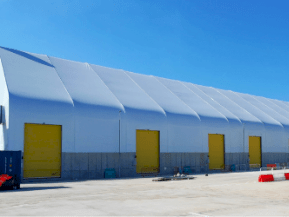Energy Efficient Buildings – Specifying High Speed Doors
Specifying a high-speed door has a number of benefits. Having the right door will save time and money, and efficiency from the outset.
The U-value contradiction
U-values are calculated as part of the design process to ensure that new buildings meet Building Regulations/Standards. The U-value assesses the rate of heat loss/gain through the thicknesses of a structure to measure its insulating properties. The lower the U-value the more heat is retained within a building.

Doors are considered closed or static when calculating U-value. Insulated roller shutters and sectional doors are often specified due to their thermal ratings because they do not meet the U-value requirements in the closed position.
However, industrial sites have frequent traffic travelling in and out of buildings, and most heat loss occurs when doors are left permanently open.

What role do high speed doors play?
Rapid operating doors offer a way to achieve significant energy savings while providing better traffic flow. There are countless high rapid doors on busy industrial estates going up and down as vehicles go in and out of the buildings.
When a shutter is open all day, the U-value and air leakage rate in the closed position become irrelevant as the heat escapes through the opening. Doors are a dynamic part of a building, therefore door usage and speed should be considered when evaluating energy performance.
Rather than being left in the open position, a high speed door is frequently opened and closed, efficiently allowing traffic in and out of the building while contributing to the thermal potential of a building through dynamic thermal performance.
Why should high speed doors be considered at design stage?
Hart pioneered the high-speed door in Britain in the early 1980s, designing the Speedor in response to a client complaining about heat escaping and cold air entering their building which affected their production and employees. Heating systems then worked overtime to maintain internal temperatures resulting in rising energy usage and costs.
Some 40 years later, since the introduction of the high-speed door to the UK market we have retrofitted countless high-speed doors. Yet even with clear efficiency and environmental benefits, they are not seen as a commodity at the design stage.
In 2015, the International Energy Conservation Code (IECC), which sets out minimum efficiency standards in America, formally recognized the efficiency benefits of high-speed doors for new construction.
Despite this, many high-speed doors in the UK are fitted at a later stage. This is because the benefits are overlooked in the initial build.
Fitting a high speed door over an existing roller shutter is possible. But the downside is it can affect production and be more costly. In our experience, it is easier and more practical to have the door installed at the build stage.
What can you do?
The rise in fuel costs and carbon neutrality are at the top of the agenda. Now is the ideal time to recognize the benefits of high-speed doors on commercial buildings.
If you are an architect, consider the benefits of specifying a high-speed door for your client. If you are a client, speak to your design team about the best possible egress options.
Understanding the usage of the entrance and designing accordingly can positively impact the internal environment. It will save time and money, and improve efficiency by having the right door for the application from the outset.
If you are looking for ways to increase the energy efficiency of your business, don’t forget to include automatic door solutions in your environmental and sustainability strategy.
To add our high speed doors to your specification please visit NBS
Contact our team to customise the best energy-saving industrial door.

